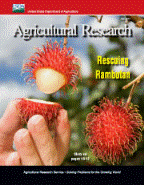United States Department of Agriculture: Agricultural Research Service, Lincoln, Nebraska

Agricultural Research Magazine
Date of this Version
8-2013
Document Type
Article
Citation
Agricultural Research 61(7): August 2013; ISSN 0002-161X
Abstract
Huanglongbing (HLB), or citrus greening, is the most serious threat to the Florida citrus industry in its history and is costing millions of dollars each year. Working with the Florida Department of Agriculture and Consumer Services (FDACS), Yongping Duan and his Agricultural Research Service colleagues in Fort Pierce, Florida, have found a formula for curbing HLB, offering the industry a glimmer of hope.
Duan has published details of work showing that heating potted citrus seedlings in greenhouses kills off the HLB bacterium and can rid the seedlings of citrus greening symptoms. Monitoring efforts show that the benefit can last for at least 2 years.
In a separate field trial, Duan has also found that heating HLB-infected trees in the sun by encasing them in plastic “tents” can prolong their productivity. Results of the field trials have yet to be published, but Duan says heating trees in solar tents may offer relief to growers whose citrus groves are being devastated. “We can’t guarantee 100-percent elimination, but it can keep production up for longer periods,” Duan says.
When a citrus tree is infected with the HLB bacterium, the pathogen resides inside the tree’s phloem tissues and blocks the passage of nutrients through its vascular system, making the tree unproductive. Infected trees can survive for 3 to 5 years, but fruit that doesn’t fall to the ground prematurely is often misshapen and sometimes will only partially ripen, making it unmarketable. There is no known cure for HLB and no commercially viable, effective treatments. It remains a threat not only to the citrus industry in Florida, where it was discovered in 2005, but to citrus-producing states nationwide.
Included in
Agriculture Commons, Animal Sciences Commons, Food Science Commons, Plant Sciences Commons

